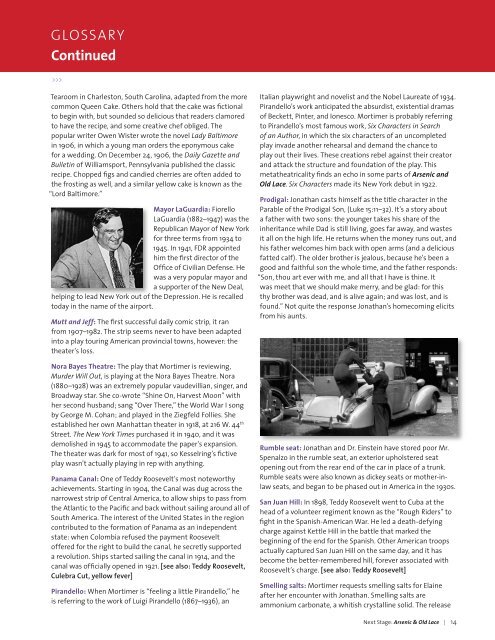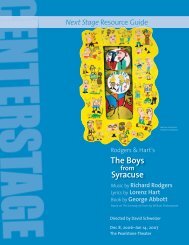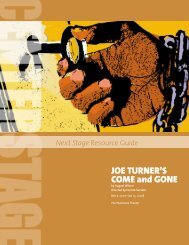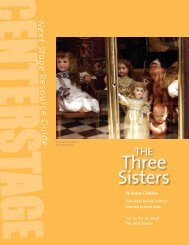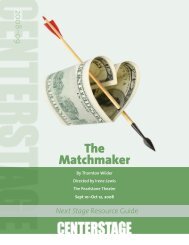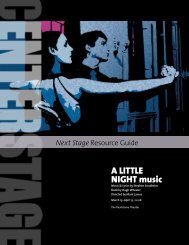Arsenic & Old lAce - Center Stage
Arsenic & Old lAce - Center Stage
Arsenic & Old lAce - Center Stage
You also want an ePaper? Increase the reach of your titles
YUMPU automatically turns print PDFs into web optimized ePapers that Google loves.
Glossary<br />
Continued<br />
>>><br />
Tearoom in Charleston, South Carolina, adapted from the more<br />
common Queen Cake. Others hold that the cake was fictional<br />
to begin with, but sounded so delicious that readers clamored<br />
to have the recipe, and some creative chef obliged. The<br />
popular writer Owen Wister wrote the novel Lady Baltimore<br />
in 1906, in which a young man orders the eponymous cake<br />
for a wedding. On December 24, 1906, the Daily Gazette and<br />
Bulletin of Williamsport, Pennsylvania published the classic<br />
recipe. Chopped figs and candied cherries are often added to<br />
the frosting as well, and a similar yellow cake is known as the<br />
“Lord Baltimore.”<br />
Mayor LaGuardia: Fiorello<br />
LaGuardia (1882–1947) was the<br />
Republican Mayor of New York<br />
for three terms from 1934 to<br />
1945. In 1941, FDR appointed<br />
him the first director of the<br />
Office of Civilian Defense. He<br />
was a very popular mayor and<br />
a supporter of the New Deal,<br />
helping to lead New York out of the Depression. He is recalled<br />
today in the name of the airport.<br />
Mutt and Jeff: The first successful daily comic strip, it ran<br />
from 1907–1982. The strip seems never to have been adapted<br />
into a play touring American provincial towns, however: the<br />
theater’s loss.<br />
Nora Bayes Theatre: The play that Mortimer is reviewing,<br />
Murder Will Out, is playing at the Nora Bayes Theatre. Nora<br />
(1880–1928) was an extremely popular vaudevillian, singer, and<br />
Broadway star. She co-wrote “Shine On, Harvest Moon” with<br />
her second husband; sang “Over There,” the World War I song<br />
by George M. Cohan; and played in the Ziegfeld Follies. She<br />
established her own Manhattan theater in 1918, at 216 W. 44 th<br />
Street. The New York Times purchased it in 1940, and it was<br />
demolished in 1945 to accommodate the paper’s expansion.<br />
The theater was dark for most of 1941, so Kesselring’s fictive<br />
play wasn’t actually playing in rep with anything.<br />
Panama Canal: One of Teddy Roosevelt’s most noteworthy<br />
achievements. Starting in 1904, the Canal was dug across the<br />
narrowest strip of Central America, to allow ships to pass from<br />
the Atlantic to the Pacific and back without sailing around all of<br />
South America. The interest of the United States in the region<br />
contributed to the formation of Panama as an independent<br />
state: when Colombia refused the payment Roosevelt<br />
offered for the right to build the canal, he secretly supported<br />
a revolution. Ships started sailing the canal in 1914, and the<br />
canal was officially opened in 1921. [see also: Teddy Roosevelt,<br />
Culebra Cut, yellow fever]<br />
Pirandello: When Mortimer is “feeling a little Pirandello,” he<br />
is referring to the work of Luigi Pirandello (1867–1936), an<br />
Italian playwright and novelist and the Nobel Laureate of 1934.<br />
Pirandello’s work anticipated the absurdist, existential dramas<br />
of Beckett, Pinter, and Ionesco. Mortimer is probably referring<br />
to Pirandello’s most famous work, Six Characters in Search<br />
of an Author, in which the six characters of an uncompleted<br />
play invade another rehearsal and demand the chance to<br />
play out their lives. These creations rebel against their creator<br />
and attack the structure and foundation of the play. This<br />
metatheatricality finds an echo in some parts of <strong>Arsenic</strong> and<br />
<strong>Old</strong> Lace. Six Characters made its New York debut in 1922.<br />
Prodigal: Jonathan casts himself as the title character in the<br />
Parable of the Prodigal Son, (Luke 15:11–32). It’s a story about<br />
a father with two sons: the younger takes his share of the<br />
inheritance while Dad is still living, goes far away, and wastes<br />
it all on the high life. He returns when the money runs out, and<br />
his father welcomes him back with open arms (and a delicious<br />
fatted calf). The older brother is jealous, because he’s been a<br />
good and faithful son the whole time, and the father responds:<br />
“Son, thou art ever with me, and all that I have is thine. It<br />
was meet that we should make merry, and be glad: for this<br />
thy brother was dead, and is alive again; and was lost, and is<br />
found.” Not quite the response Jonathan’s homecoming elicits<br />
from his aunts.<br />
Rumble seat: Jonathan and Dr. Einstein have stored poor Mr.<br />
Spenalzo in the rumble seat, an exterior upholstered seat<br />
opening out from the rear end of the car in place of a trunk.<br />
Rumble seats were also known as dickey seats or mother-inlaw<br />
seats, and began to be phased out in America in the 1930s.<br />
San Juan Hill: In 1898, Teddy Roosevelt went to Cuba at the<br />
head of a volunteer regiment known as the “Rough Riders” to<br />
fight in the Spanish-American War. He led a death-defying<br />
charge against Kettle Hill in the battle that marked the<br />
beginning of the end for the Spanish. Other American troops<br />
actually captured San Juan Hill on the same day, and it has<br />
become the better-remembered hill, forever associated with<br />
Roosevelt’s charge. [see also: Teddy Roosevelt]<br />
Smelling salts: Mortimer requests smelling salts for Elaine<br />
after her encounter with Jonathan. Smelling salts are<br />
ammonium carbonate, a whitish crystalline solid. The release<br />
Next <strong>Stage</strong>: <strong>Arsenic</strong> & <strong>Old</strong> Lace | 14


